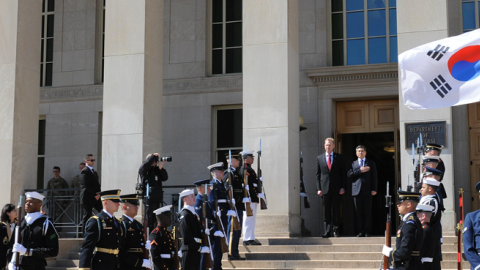As South Korean President Moon Jae-in visits the United States for the fifth time in two years, both countries need to stay alert to fault lines emerging in their alliance and in managing North Korea.
Despite predictable talking points about an “ironclad” alliance and persistent optimism about talks with North Korea, a Moon-Trump press conference at the White House is unlikely to erase festering doubts about bilateral relations or Kim Jong Un.
Why do concerns loom over a successful, longstanding alliance? Just two weeks ago at the Pentagon, Acting Defense Secretary Patrick Shanahan and South Korean Defense Minister Jeong Kyeong-doo demonstrated unity and echoed the alliance slogan, “Katchi kapshida” (“we go together”).
But searing questions nag alliance managers.
First, do the allies agree on the alliance’s evolving and future purpose, regardless of whether diplomacy with North Korea succeeds or fails? Should peace and denuclearization actually result, will Seoul and Washington agree on the objective the alliance? Conversely, should Kim fail to take a serious step toward denuclearization, or conduct a provocation to include a so-called space launch, will both allies be willing to return to a “maximum pressure” campaign, including military pressure? Or, will inter-Korean peace so outstrip denuclearization that Pyongyang is able to drive a wedge into the heart of the alliance?
Second, even if the allies have more time to think about the future raison d’etre, will they take sufficient action to avoid declining military readiness to handle the unexpected? The relaxation of major combined exercises undeniably erodes capability. If the United States and North Korea agree to a comprehensive agreement with phased implementation, diplomacy can be expected to trudge on slowly, without sapping the Korean People’s Army nuclear or conventional military forces. Will both allies maintain sufficient defense readiness?
Staying ready for Korean contingencies involves more than two actors. How can the United States help defend South Korea when Seoul and Tokyo are at daggers drawn over military incidents such as the December dust-up involving a Republic of Korea (ROK) Navy combatant locking its fire-control radar onto a Japanese maritime patrol aircraft? The defense of Korea is intimately connected to U.S. bases in Japan, and to the extent they become decoupled, readiness will be further weakened.
Then there is the issue of accelerating the transition of peacetime operational control (OPCON) from U.S. to ROK forces The two sides have agreed to make the OPCON change, based on the conditions of South Korea readiness and a degree of peace with North Korea, and yet both issues are subjective judgments that could divide, rather than unite, the allies.
Third, will Seoul and Washington fall out over burden-sharing over the mid-to-long term? The rancor that preceded the signing of a Special Measures Agreement this year raised questions about terms for a multi-year deal. South Korea agreed to increase its host-nation support from $800 million to $1 billion a year, and Seoul also agreed to major purchases of U.S. defense hardware. But the fact that the deal required a public feud and resulted in only a one-year extension hardly provides the predictability that should accompany such a vital alliance, and at a time when other regional partners wonder out loud about America’s future reliability.
Concerns about the alliance are apt to be brushed aside during Moon’s visit, if only because the agenda centers on coordinating North Korean negotiating strategies. President Donald Trump conducted his second summit meeting with Kim in Hanoi at the end of February and President Moon is expected to meet by month’s end to mark the one-year anniversary of the Panmunjom Declaration
Both Moon and Trump remain encouraged by Kim’s apparent commitment to a permanent peace and complete denuclearization. But the reality is that ineffective diplomacy could give way to a phony peace that, over time, produces a more dangerous situation.
Regardless of Pyongyang’s negotiation strategy and tactics, a strong and certain alliance will help both Seoul and Washington navigate whatever an unaccountable leader such as Kim might do next.
Another way to prevent a hollow alliance or a spurious peace is by the daily vigilance of an independent legislative branch. The American people rely on Congress to conduct public and private hearings to ensure transparency when it comes to maintaining a lynchpin alliance and the protracted challenge of negotiating with North Korea.



















